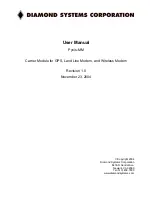
Remote Devices
Ethernet/USB/Cellular
Processor
Local
Registers
Display
I/O Base
Internal
Radio
10.3.1 Basic Approach to Configuration
When programming an application in the DXM Controller, the first step is to plan the overall data structure of the Local
Registers.
The Local Registers are the main storage elements in the DXM Controller. Everything goes into or out of the Local
Registers. Start by naming the Local Registers in the application as this helps to provide the beginning structure of the
application.
After you have a basic idea what data values to store, configure the read/write rules to move the data. The Read/Write
rules are simple rules that move data between devices and the Local Registers.
Most applications require the ability to manipulate the Local Register data, not just move data around. Use the Action rules
to make decisions or transform the data after the data is in the Local Registers. Action rules can apply many different
functions to the Local Register data, including conditional statements, math operations, copy operations, or trending.
To perform scheduled events in Local Registers, look under the Scheduler tab in the DXM Configuration Tool. These rules
provide the ability to create register events by days of the week. The scheduler can also create events based on sunrise or
sunset.
10.3.2 Troubleshooting a Configuration
The built-in Register View utility is found in the DXM Configuration Tool on the Register View screen.
When a configuration is running on the DXM Controller, this utility can read or write Local Registers to help understand
application operation. The utility can also access data from remote devices, making it easier to troubleshoot a
configuration.
Local Registers can also be configured to show register data on the LCD menu to view Local Register data without having
the controller connected to a PC. On the Local Registers tab, set the read permissions on each register to be display on
the LCD.
10.3.3 Saving and Loading Configuration Files
The DXM Configuration Tool saves its configuration information in a XML file. Use the File menu to Save or Load
configuration files.
Save the configuration file before attempting to upload the configuration to the DXM Controller. The DXM Configuration
Tool uploads the configuration file saved on the PC to the DXM Controller; it will not send the configuration loaded in the
tool.
10.3.4 Uploading or Downloading Configuration Files
The DXM Controller requires a XML configuration file to become operational. To upload or download configuration files,
connect a computer to the DXM Controller using the USB port or Ethernet port. Then use the Upload Configuration to
Device or Download Configuration from Device under the Device menu.
DXM100-Bx Wireless Controller Instruction Manual
www.bannerengineering.com - Tel: 763.544.3164
73










































